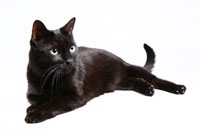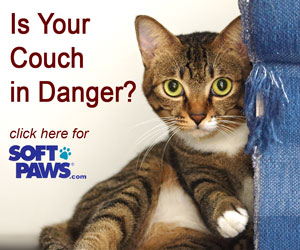Cat Drooling

If you've ever seen a cat foam at the mouth after riding in a car to the vet's office or getting a dose of medicine, you know that a little drool goes a very long way! But while you're hunting for an absorbent towel, you may wonder if your cat's drooling is normal or a sign of a problem.
Causes of Occasional, Short-Term Drooling in Cats
Some common causes of cat drooling are behavioral, fairly benign, and quite short-lived. These include:
- Salivation from fear or extreme excitement.
- Car sickness caused by motion or fear.
- Nausea causes some cats to smack their lips and foam at the mouth, and others drool excessively before vomiting a hairball.
- Occasionally, a cat drools with pleasure while being petted. This is described in more detail in the article "Why Do Cats Drool?"
More Serious Causes of Cat Drooling
Abnormal drooling in cats is caused by problems that occur inside the mouth and those that originate elsewhere in the body.
The following are some examples of conditions in the mouth that may lead to drooling:
- Dental disease is a big cause of cat drooling. This may include broken, decayed, or abscessed teeth. More than 80% of adult cats will develop periodontal, gum, or other oral diseases that cause pain and may lead to drooling.
- Oral foreign bodies almost always cause drooling. Common objects that get stuck in cats' mouths include fish hooks, bones, string that becomes wrapped around the base of the tongue, and sticks.
- Oral cancers of the gums, tongue, or other structures can be very aggressive in cats and cause a high volume of drooling, sometimes tinged with blood.
- Ulcers and lacerations cause pain and drooling when they occur in a cat's oral cavity.
- Cysts or infections in a cat's salivary glands may cause drooling.
- Cats sometimes try to catch bees and receive painful mouth stings that may result in drooling.
Other signs of oral disease that may accompany drooling are foul breath, blood-tinged saliva, difficulty eating, or refusal to eat the usual foods. The cat may look uncomfortable and paw at her mouth. Sometimes drooling is the first and only sign of an oral problem.
If your cat is drooling or foaming at the mouth for no obvious reason, drooling persists for more than half an hour, or there are other signs of illness simultaneously, it's time to call the vet.
Conditions elsewhere in the body that can cause drooling include:
- Pain anywhere in the body may result in drooling in some cats.
- Nausea in cats is a common cause of excessive salivation and drooling.
- Neurologic conditions that interfere with a cat's ability to swallow can lead to an overflow of saliva from the mouth.
- Disorders of the esophagus, stomach, or intestines may all result in drooling.
- Portosystemic shunt, a rare liver disease that results in a build-up of toxins in the blood, may cause excessive drool to occur.
- Advanced kidney disease in cats may be accompanied by drooling and foul breath.
- It is common to fear rabies when a cat is producing excessive saliva. Luckily, this serious virus is only diagnosed rarely. However, if a cat has not been vaccinated against rabies and begins drooling and acting abnormally, it must be considered.
- Exposure to toxins or caustic chemicals often causes drooling in cats, as described below.
Toxin Exposure Is a Common Cause of Drooling in Cats
Exposure to toxins is an important consideration in a cat that is drooling. Some household cleaning products, ingested directly or licked off the fur, as well as some houseplants may burn the lining of the mouth and cause drooling. Many flea dips, spot-on flea preventatives, and insecticides are very toxic to cats and may cause drooling. These products usually also cause additional signs off illness such as vomiting, muscle tremors, weakness, and lethargy. If your cat is showing these signs or you suspect that she was exposed to a toxic chemical, seek veterinary care immediately. Bring labels or product information with you if possible.
You May Also Like These Articles:
The Dangers of Strings, Ribbons, and Yarn for Cats
How To Know When Your Cat Is Sick
Dehydration in Cats: How Can You Tell If A Cat Is Dehydrated?
Sago Palms Can Be Lethal to Cats
Foods Toxic to Cats - Slideshow
Notice: Ask-a-Vet is an affiliated service for those who wish to speak with a veterinary professional about their pet's specific condition. Initially, a bot will ask questions to determine the general nature of your concern. Then, you will be transferred to a human. There is a charge for the service if you choose to connect to a veterinarian. Ask-a-Vet is not manned by the staff or owners of CatHealth.com, and the advice given should not delay or replace a visit to your veterinarian.






